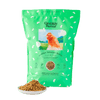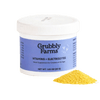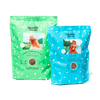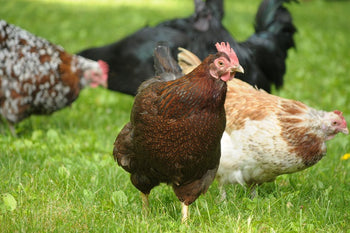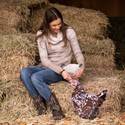Fowl pox, or avian pox, can become a health hazard for backyard flocks. Avian pox only affects poultry and other bird species, though it can spread through infected birds and insects. Learning the proper prevention, detection, and treatment methods of fowl pox can help you catch an infection before it becomes serious.
What is Fowl Pox?
Fowl pox is a viral infection that affects bird species worldwide. It infects both domestic and wild avian species including chickens, ducks, turkeys, geese, pheasants, quail, canaries, and hawks. Fowl pox is not the same as chicken pox, and mammals cannot contract fowl pox infections or any other avipoxviruses (1). In cases where virus carriers or exposure is prevalent, fowl pox can spread quickly through a flock. Thus, proper prevention and infection management can help you keep the virus under control.
Avian Pox Variants
There are two forms of fowl pox: dry pox and wet pox. Dry pox (cutaneous) is the most prevalent form in backyard flocks. It is especially common in mosquito-infested areas and during warmer months. Wet pox (diphtheritic) is a less common form and is more prevalent during the colder season.
Cutaneous (Dry) Pox- The cutaneous variant of fowl pox affects the sick bird’s skin. It is usually a temporary viral infection that chickens can recover from on their own with proper supportive care. Dry pox infections can develop into wet pox infections if the virus is not controlled, and typically spreads through infection via wounds. Mosquitos are known carriers of avian pox and can spread the virus from one infected bird to another through bites. Open wounds from injuries or fighting can make a chicken more susceptible to dry pox, and the scabs that form and fall off during a dry pox infection can lead to reinfection or spread of the virus.
Diphtheritic (Wet) Pox- The wet pox variant affects the mucus membranes in the upper respiratory tract. It is a more serious form of fowl pox that can lead to death. Wet pox can also lead to dry pox infections, and different birds within the same flock can be infected with either fowl pox variant at the same time. Wet pox infections spread when chickens inhale infectious dust and dander. This means it’s less likely to spread from wild birds to domestic birds; however, it will spread rapidly within a flock unless strict cleaning practices are in place.

Identifying the Disease: Recognizing Symptoms of Fowl Pox
Several clinical symptoms may indicate a fowl pox infection. Since dry pox and wet pox are different variants of the virus, their symptoms are unique and can help you distinguish which form has infected your flock.
Dry pox is characterized by external symptoms. Lesions will form on non-feathered skin areas such as the comb, wattles, earlobes, eyelids, and face. In some cases, lesions will also form on the skin of a bird’s feet, legs, and around the vent. The lesions will eventually join to create yellow, puss-filled warts that develop black scabs and eventually fall off. The scabs will leave scars on the skin and can shed the virus to other birds. Severe cases of dry pox will result in scabs large enough to inhibit a chicken from seeing or eating properly.
Here are the main symptoms indicating a dry pox infection:
- Lesions on skin
- Wart-like bumps on featherless skin
- White pimp-like bumps
- Black scabs
Wet pox is characterized by respiratory, or internal, symptoms. Respiratory distress and lesions inside the mouth and windpipe can be signs of a wet pox infection. As the virus progresses, the lesions inside the mouth can inhibit proper breathing and swallowing, which can cause death through suffocation or starvation.
These are signs that a chicken has wet pox:
- Rales
- Wheezing
- Nasal or eye discharge
- Yellowish, curd-like bumps in the mouth & windpipe
Differential Diagnosis
You may mistake fowl pox for other avian diseases or even just simple injuries. Black scabs and white dots commonly form on a chicken’s comb and wattles from fighting, injury, or frostbite. However, if these maladies spread or grow larger, you may suspect a dry pox infection. Similarly, the wet form of fowl pox can be mistaken for gapeworms or other respiratory issues.
Consulting a veterinarian for an accurate diagnosis is the best way to confirm a fowl pox infection. A laboratory test can also confirm the presence of the virus.

Effects of Fowl Pox on Chickens
Fowl pox negatively affects the health of individual chickens and the entire flock. Even if just one bird becomes infected, both dry and wet forms of the disease can spread gradually throughout the flock and cause the following problems:
- Stress
- Reduced egg production
- Weight loss
- Retarded growth in young birds
Economic Consequences
Fowl pox infections can also have economic consequences in the egg-producing industry. For one, avian pox infections can cause a drop in laying, creating a loss in production and lower egg availability. Since wet pox infections can be fatal, it has an even greater impact on the industry.
Not to mention, the treatment for fowl pox can be time-intensive and expensive, requiring vigilant tending to the pox scabs and strict cleaning practices. Even though the fowl pox vaccine is relatively inexpensive, it must be individually administered to all the birds in a flock.
Treatment and Management
Fowl pox must be managed as soon as it is diagnosed for successful recovery. Once a bird recovers, it may be a carrier of the virus for life. If the exposure is gradual enough, other birds in the flock can build immunity to the virus and not become infected. However, any new birds added to the flock will be susceptible to the virus if they don’t have immunity.
Here are some of the ways to manage a fowl pox infection in your flock:
Veterinary Consultation- If you suspect a fowl pox infection, whether it be dry pox or wet pox, seek advice from a veterinarian or avian expert. They can help confirm a diagnosis and suggest treatment plans. If the infection is caught in time, you may be able to vaccinate your birds to prevent the infection from progressing and spreading. There is no treatment for fowl pox other than providing supportive care while the chicken’s body fights the virus (1).
Supportive Care- Supportive care helps an infected chicken recover and fight the virus. Chickens infected with fowl pox should be quarantined away from healthy chickens, which can help prevent the spread of infection. If you need to quarantine multiple birds, ensure there is plenty of space in the quarantine area. Overcrowding can lead to stress and worsen symptoms.
Provide the quarantined chickens with a balanced feed for proper nutrition and plenty of water. This will support a chicken’s immune system to help fight the virus. You can also add probiotics to the water to support gut health or add electrolytes for better hydration.
For dry pox, lesions on the infected chicken should heal within 4 weeks. To aid the healing process, dab Betadine on each lesion daily to prevent bacterial infections and help the lesions dry up (2). If the scabs inhibit a chicken from seeing or eating properly (lesions on the eyelids and around the beak), soften the scabs with a warm saline solution, applied with a cotton swab. The lesions will gradually become bigger before they heal, eventually forming scabs and falling off.
In the case of wet pox, watch for a build-up of thick mucus or discharge in the throat, which can keep a chicken from breathing and eating properly. You can provide relief by using a cotton swab and some Betadine to remove the mucus discharge (2). Consult a veterinarian in the event of severe wet pox infections. They may recommend a broad-spectrum antibiotic to prevent any bacterial infections.
Vaccination- The fowl pox vaccine is an injection of the live virus that gives the chicken a mild case of the disease. As the chicken heals, it will develop immunity (2).
You can vaccinate chickens against fowl pox as early as 12-16 weeks of age. Only vaccinate chickens that are healthy and have no other pre-existing health conditions, which will prevent the vaccine from causing a severe infection. After inoculation, watch for symptoms of fowl pox and be prepared to treat mild cases of the virus. Chickens may develop a fever within 10 days of being vaccinated. This is a normal result and the chickens should recover within a few days. Signs of a fever include eating less, low activity, and watery droppings, and hens may stop laying for a time.
Check the vaccinated birds a week later to see if the vaccination was successful. This is called checking for ‘takes’. A successful ‘take’ will appear as a pimple-like swelling or scab at the vaccine injection site (2). If a large percentage of the vaccinated chickens do not have a ‘take’, you will need to revaccinate with a fresh vaccine. ‘Non-takes’ could also indicate that the chicken already had immunity to the virus. A ‘take’ that is larger than a pimple and filled with puss means contamination and possible infection. Treat the infected ‘take’ as you would any wound or abscess.
In areas where mosquitoes are prevalent all year, two rounds of vaccination may be necessary. In these cases, you may vaccinate young chicks as early as a day old. However, this will only give them temporary immunity to the virus, and they will need to be revaccinated at 12-16 weeks of age.

Biosecurity Measures
You can prevent the exposure and transmission of fowl pox to your flock through proper biosecurity measures, including:
Mosquito & Fly Control- One of the best ways to prevent exposure to fowl pox is to control mosquito and fly populations near the chicken coop, enclosure, and yard. These pests can spread the virus or cause bite wounds that lead to infection from exposure. Use pet-friendly mosquito repellents and plant insect-repellent herbs around the coop. Consider using fly tapes as well. Localized mosquito spraying may be necessary in regions where they are prevalent.
Clean & Disinfect- After a flock has recovered from a fowl pox infection, thoroughly clean and disinfect the chicken coop, which can help remove infective scabs that were shed from healing chickens. Cleaning will also get rid of feathers, dust, and dander that can spread the virus. To ensure the virus is completely eradicated, clean and disinfect the coop weekly for 4 weeks following an infection.
Quarantine- Chickens that were not raised on your property may be carriers of the virus even if they show no symptoms. Quarantine new birds for at least 3-4 weeks before integrating them into your flock. During this period, watch for signs of illness or infection that may indicate they need treatment before integrating with your chickens.
Conclusion
Fowl pox is a contagious viral disease that can infect chickens and other poultry. The dry form causes external lesions on featherless skin areas and the wet form causes internal lesions in the mouth.
A chicken can recover from fowl pox if it receives proper supportive care. However, wet pox infections are more serious and can lead to death, so consult a veterinarian when you recognize signs of infection. Be vigilant about biosecurity and strengthening your flock’s immune systems so they can stay healthy and pox-free!
- Fowlpox in Chickens and Turkeys - Poultry - Merck Veterinary Manual (merckvetmanual.com)
- Damerow, Gail. The Chicken Health Handbook: A Complete Guide to Maximizing Flock Health & Dealing with Disease. Storey Publishing, 2015
